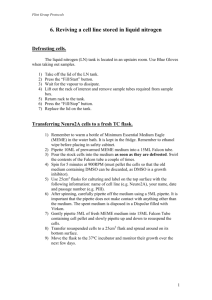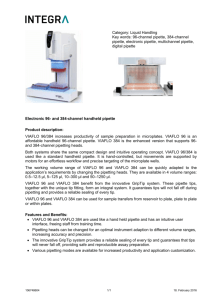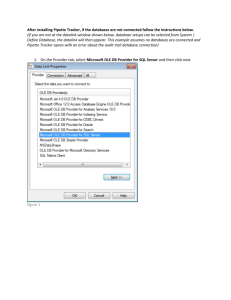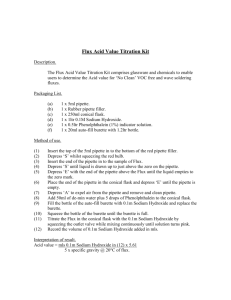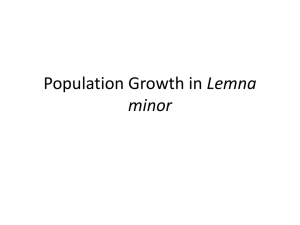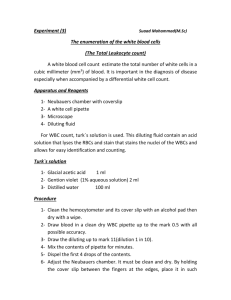Acids and Bases
advertisement
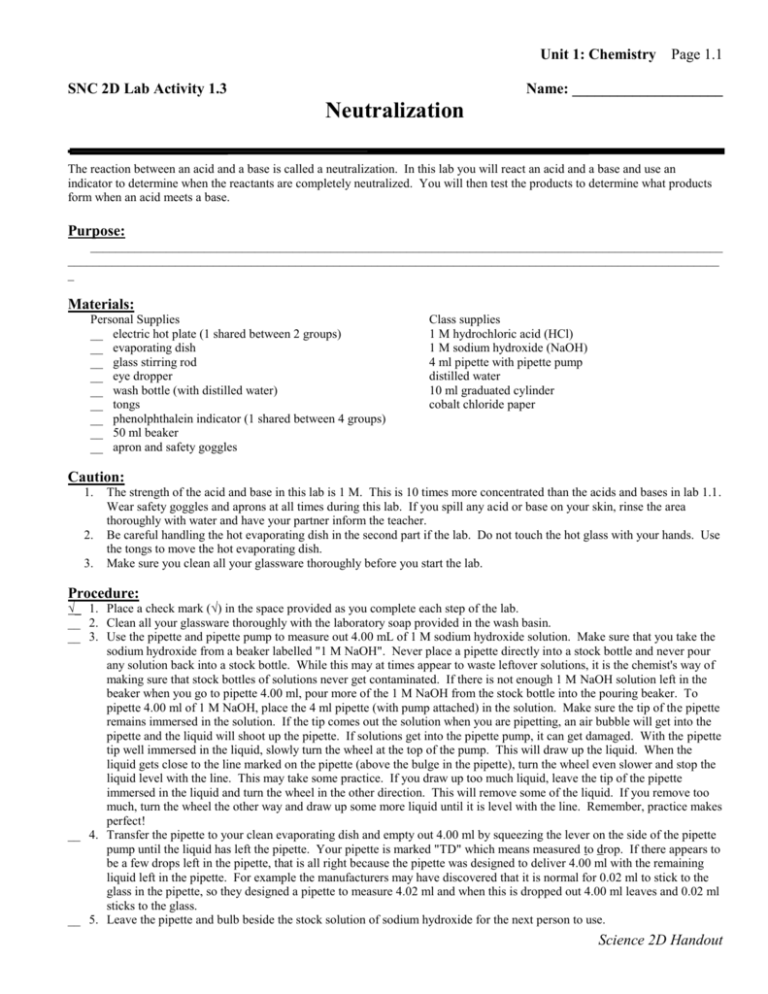
Unit 1: Chemistry SNC 2D Lab Activity 1.3 Page 1.1 Name: ____________________ Neutralization The reaction between an acid and a base is called a neutralization. In this lab you will react an acid and a base and use an indicator to determine when the reactants are completely neutralized. You will then test the products to determine what products form when an acid meets a base. Purpose: ____________________________________________________________________________________________________ _______________________________________________________________________________________________________ _ Materials: Personal Supplies __ electric hot plate (1 shared between 2 groups) __ evaporating dish __ glass stirring rod __ eye dropper __ wash bottle (with distilled water) __ tongs __ phenolphthalein indicator (1 shared between 4 groups) __ 50 ml beaker __ apron and safety goggles Class supplies 1 M hydrochloric acid (HCl) 1 M sodium hydroxide (NaOH) 4 ml pipette with pipette pump distilled water 10 ml graduated cylinder cobalt chloride paper Caution: 1. 2. 3. The strength of the acid and base in this lab is 1 M. This is 10 times more concentrated than the acids and bases in lab 1.1. Wear safety goggles and aprons at all times during this lab. If you spill any acid or base on your skin, rinse the area thoroughly with water and have your partner inform the teacher. Be careful handling the hot evaporating dish in the second part if the lab. Do not touch the hot glass with your hands. Use the tongs to move the hot evaporating dish. Make sure you clean all your glassware thoroughly before you start the lab. Procedure: √_ 1. Place a check mark (√) in the space provided as you complete each step of the lab. __ 2. Clean all your glassware thoroughly with the laboratory soap provided in the wash basin. __ 3. Use the pipette and pipette pump to measure out 4.00 mL of 1 M sodium hydroxide solution. Make sure that you take the sodium hydroxide from a beaker labelled "1 M NaOH". Never place a pipette directly into a stock bottle and never pour any solution back into a stock bottle. While this may at times appear to waste leftover solutions, it is the chemist's way of making sure that stock bottles of solutions never get contaminated. If there is not enough 1 M NaOH solution left in the beaker when you go to pipette 4.00 ml, pour more of the 1 M NaOH from the stock bottle into the pouring beaker. To pipette 4.00 ml of 1 M NaOH, place the 4 ml pipette (with pump attached) in the solution. Make sure the tip of the pipette remains immersed in the solution. If the tip comes out the solution when you are pipetting, an air bubble will get into the pipette and the liquid will shoot up the pipette. If solutions get into the pipette pump, it can get damaged. With the pipette tip well immersed in the liquid, slowly turn the wheel at the top of the pump. This will draw up the liquid. When the liquid gets close to the line marked on the pipette (above the bulge in the pipette), turn the wheel even slower and stop the liquid level with the line. This may take some practice. If you draw up too much liquid, leave the tip of the pipette immersed in the liquid and turn the wheel in the other direction. This will remove some of the liquid. If you remove too much, turn the wheel the other way and draw up some more liquid until it is level with the line. Remember, practice makes perfect! __ 4. Transfer the pipette to your clean evaporating dish and empty out 4.00 ml by squeezing the lever on the side of the pipette pump until the liquid has left the pipette. Your pipette is marked "TD" which means measured to drop. If there appears to be a few drops left in the pipette, that is all right because the pipette was designed to deliver 4.00 ml with the remaining liquid left in the pipette. For example the manufacturers may have discovered that it is normal for 0.02 ml to stick to the glass in the pipette, so they designed a pipette to measure 4.02 ml and when this is dropped out 4.00 ml leaves and 0.02 ml sticks to the glass. __ 5. Leave the pipette and bulb beside the stock solution of sodium hydroxide for the next person to use. Science 2D Handout Page 1.2 Unit 1: Chemistry __ 6. Return to your work area and add 3 drops of colourless phenolphthalein indicator to the sodium hydroxide solution in your evaporating dish. Make a note of the colour produced. Record your observations in the space provided in the Observations section. __ 7. Use the 10.0 ml graduated cylinder beside the stock bottle of 1 M HCl to measure approximately 6 ml of 1 M HCl. Remember to pour from the stock bottle into the pouring beaker and then into the graduated cylinder. The stock bottle, pouring beaker and graduated cylinder should all be marked "1 M HCl". These labels help reduce the chances of contaminating lab samples. Transfer the 6 ml of 1 M HCl to a small 50 ml beaker and take the small beaker back to your work area. __ 8. Add 1 M hydrochloric acid solution to the base drop by drop by using the eye dropper.. Stir the solution in the evaporating dish with the glass stirring rod as the acid is added. Continue to add the acid a drop at a time until the colour just disappears. Note the colour change in your observations. __ 9. Place the evaporating dish with the solution in it on an electric hot plate and heat the evaporating dish. As the solution is evaporating, hold a piece of cobalt chloride paper over the vapour using tongs and note the colour of the paper before and after exposure to the vapour. __ 10. Heat the evaporating dish until the solution has evaporated to dryness. As the dish nears dryness, spattering may result. Heat the dish very gently at this stage of the evaporation. __ 11. Turn the hot plate off and remove the evaporating dish from the hot plate using the tongs. Describe the appearance of the residue. Ask the teacher what the substance tastes like but do not taste it yourself. (Be careful: the dish will be hot!) Record your observations. __ 12. Clean and put away all equipment. __ 13. Complete the discussion questions and write a conclusion. Observations: Discussion: 1. What are the two functions of phenolphthalein in this lab activity? 2. Was the solution basic, acidic, or neutral after you stopped adding the acid? Explain. 3. a) Anhydrous cobalt chloride paper is blue. ("Anhydrous" means without water.) When anhydrous cobalt chloride combines with water, it turns pink forming cobalt chloride hydrate. ("Hydrate" means with water.) Use this information to identify one of the products of the reaction between the acid and the base. b) Identify the other product by naming a common substance that tastes like the residue. 4. a) Write a word equation for the reaction that took place between the hydrochloric acid and the sodium hydroxide: ______________ + ____________ ____> ____________ + ___________ b) Write a chemical equation for the reaction: _____ ____ ( ) + ____ ( ) > ____ ( ) c) Write a balanced chemical equation for the reaction: ____ ( _ _ _ _ ( ) _____> ____ ) + + ( ____ ) + ( ) ____ ( ) Conclusion: _______________________________________________________________________ _________________________________________________________________________ _ Science 2D Handout
